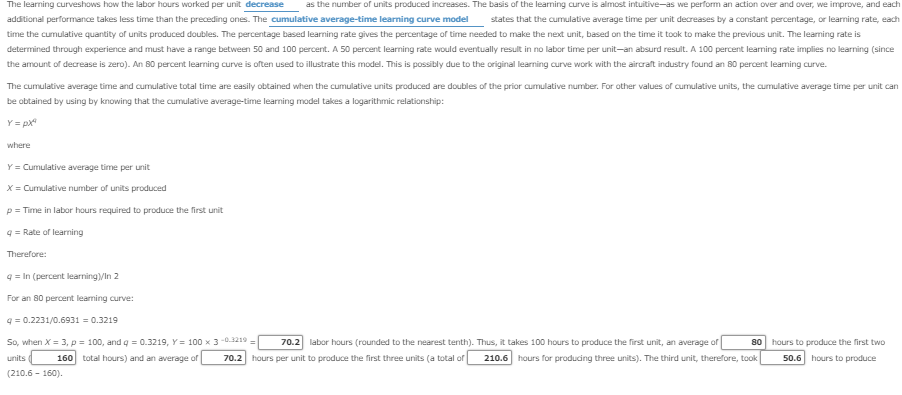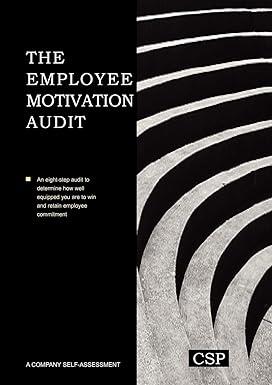Cumulative Learning Curve: Please fill in all the blanks!


The learning curveshows how the labor hours worked per unit decrease as the number of units produced increases. The basis of the learning curve is almost intuitive-as we perform an action over and over, we improve, and each addtional performance takes less time than the preceding ones. The cumulative average-time learning curve modelstates that the cumulative average time per unit decreases by a constant percentage, or learning rate, each time the cumulati e quantity or units produced do ble s -peter tage ba ed i arri rete nest percentagedtimer eded mac tre ret uti base o ith trei l tab ti m-th preiosui . hele ri rete1 determined through experience and must have a range between 50 and 100 percent. A 50 percent learning rate would evenitually result in no labor time per unit-an absurd result. A 100 percent learning rate implies no learning (since the amount of decrease is zero). An 80 percent learning curve is often used to illustrate this model. This is possibly due to the original learning curve work with the airoraft industry found an 80 percent learning curve. The cumulative average time and cumulative total time are easi uaned wher the cumulat e units produce are du bied.-Pro amul Itin num e f..ther autommulato urit n cumula w cavero timr.nca be obtained by using by knowing that the cumulative average-time learning model takes a logarithmic relationship where Cumulative average time per unit X-Cumulative number of units produced p-Time in labor hours required to produce the first unit Rate of learning -In (percent learning)V/in 2 For an 80 percent learning curve: 4-0.2231/0.6931-0.3219 So, when X = 3, p 100, and q = 0.3219, Y= 100 3 0 3219 70.2 labor hours rounded to the nearest tenth). Thus, it takes 100 hours to produce the first unit, an average or 80 hours to produce the first two units 160 total hours) and an average o 702 hours per unit to produce the first three units (a total of 2106 hours for produding thireeunts), The third unit, therefore,ook S0.6ours to produce (210.6- 160) Applying the Concepts Medcom Company installs computerized patient record systems in hospitals and medical centers. Medcom has noticed that each general type of system is subject to an 80 percent learning curve. The installation takes a team of professionals to setup and completely test the system. Required 1. Assume that the first installation takes 800 hours, and the team of professionals is paid an average of $50 per hour.Complete the following table for Medcom Company (round answers to one decimal place): Cumulative Number Cumulative Average Time per System (in Hours) Cumulative Total of Systems Labor Hours 16 32 2. Using the data table above, calculate the total labor cost of Medcom installing four systems: Tuta Labor cost (round to the nearest dolar) 3. Using the data table above, calculate the following for Medcom to produce a third system a. Cumulative average time to produce the third system (round to the nearest tenth): b. Total time required to produce three systems (round to the nearest tenth) C. Time to produce the third system (round to the nearest tenth): hours hours hours The learning curveshows how the labor hours worked per unit decrease as the number of units produced increases. The basis of the learning curve is almost intuitive-as we perform an action over and over, we improve, and each addtional performance takes less time than the preceding ones. The cumulative average-time learning curve modelstates that the cumulative average time per unit decreases by a constant percentage, or learning rate, each time the cumulati e quantity or units produced do ble s -peter tage ba ed i arri rete nest percentagedtimer eded mac tre ret uti base o ith trei l tab ti m-th preiosui . hele ri rete1 determined through experience and must have a range between 50 and 100 percent. A 50 percent learning rate would evenitually result in no labor time per unit-an absurd result. A 100 percent learning rate implies no learning (since the amount of decrease is zero). An 80 percent learning curve is often used to illustrate this model. This is possibly due to the original learning curve work with the airoraft industry found an 80 percent learning curve. The cumulative average time and cumulative total time are easi uaned wher the cumulat e units produce are du bied.-Pro amul Itin num e f..ther autommulato urit n cumula w cavero timr.nca be obtained by using by knowing that the cumulative average-time learning model takes a logarithmic relationship where Cumulative average time per unit X-Cumulative number of units produced p-Time in labor hours required to produce the first unit Rate of learning -In (percent learning)V/in 2 For an 80 percent learning curve: 4-0.2231/0.6931-0.3219 So, when X = 3, p 100, and q = 0.3219, Y= 100 3 0 3219 70.2 labor hours rounded to the nearest tenth). Thus, it takes 100 hours to produce the first unit, an average or 80 hours to produce the first two units 160 total hours) and an average o 702 hours per unit to produce the first three units (a total of 2106 hours for produding thireeunts), The third unit, therefore,ook S0.6ours to produce (210.6- 160) Applying the Concepts Medcom Company installs computerized patient record systems in hospitals and medical centers. Medcom has noticed that each general type of system is subject to an 80 percent learning curve. The installation takes a team of professionals to setup and completely test the system. Required 1. Assume that the first installation takes 800 hours, and the team of professionals is paid an average of $50 per hour.Complete the following table for Medcom Company (round answers to one decimal place): Cumulative Number Cumulative Average Time per System (in Hours) Cumulative Total of Systems Labor Hours 16 32 2. Using the data table above, calculate the total labor cost of Medcom installing four systems: Tuta Labor cost (round to the nearest dolar) 3. Using the data table above, calculate the following for Medcom to produce a third system a. Cumulative average time to produce the third system (round to the nearest tenth): b. Total time required to produce three systems (round to the nearest tenth) C. Time to produce the third system (round to the nearest tenth): hours hours hours








